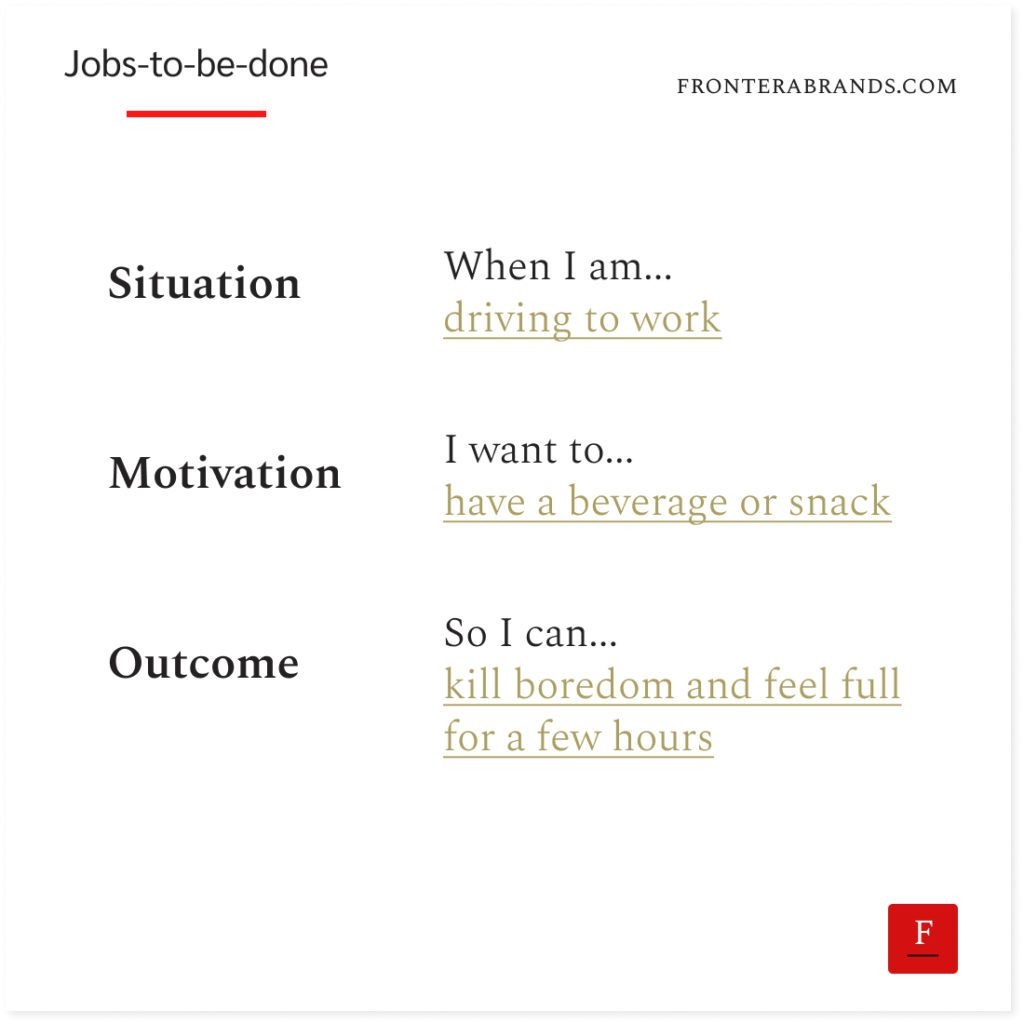About 10 years ago, McDonald’s marketing team received an objective from their management.
Increase milkshake sales.
How hard could it be?
Especially for a sophisticated marketing team with an unlimited budget.
So they created a focus group that fit the milkshake buyer persona, based on data of millions of customers.
And made interviews with them to improve the milkshake.

Flavors, calories, size…
They asked about all the milkshake attributes to figure out what would make them buy more.
And they implemented the findings from the interviews.
Result?
No change in milkshake sales.
They did a few more experiments, but nothing worked.
So they gave up.
And decided to hire help from Harvard Business School Professor and business consultant Clayton Christensen.
Finding the job-being-done
Christensen sent a researcher to a McDonald’s branch with high milkshake sales.
He sat there for a day and took detailed notes.
When did the customers buy milkshakes?
Did they buy milkshakes with other meals or alone?
Did they drink it there or drive away?
And he found a strange pattern.
Half of the milkshake sales were before 8:30 a.m.
And these customers always bought only a milkshake, they were alone, and immediately drove away after the purchase.
Christensen decided to confront these customers to figure out what was going on.
Why were they buying a milkshake so early in the morning?
What was the “job” they hired a milkshake for?
Turns out these people were driving to work.
And they needed something to kill boredom during the ride that also kept them full.
Makes sense, but why a milkshake?
So Christensen asked what were the alternatives they hired for the same job before.
The answers gave the real insights McDonald’s needed:
- “I hired a banana, but it only lasts a minute and you get hungry in an hour.”
- “I hired a donut, but the pieces fall to my shirt and my hands get dirty while driving.”
- “I hired a Snickers, but I felt guilty.”
- “Milkshake is better. Because it lasts longer, keeps me full for hours, and is easy to drink while driving.”
Boom.
It was not about certain demographics, flavors, or calories.
Customers had a specific job to be done.
And a milkshake was the best for it.
Knowing why customers buy a milkshake changed everything for the McDonald’s team.
They reverted what came from the focus group — like low calories and new flavors.
Instead, they increased the thickness of the milkshake to make it last longer.
They also made it quicker to buy milkshakes.
And of course, they prepared a new campaign around these value propositions.
Result?
Milkshake sales increased by 400%.
Christensen applied the same to different companies.
It worked like magic.
Three benefits of thinking in jobs-to-be-done:
- Increase the product’s value: When companies know what their customers really want to achieve, it’s much easier to create the best product for the job. And this makes marketing and sales much easier.
- Know the real competition: McDonald’s marketing team always thought they were competing with Burger King’s milkshake. But the real competition was donuts, bananas, and even chocolate bars. That also meant the potential market size was much bigger.
- Identify unmet needs: When you think of jobs, you start to see unmet needs everywhere. So you can create solutions to problems that nobody else can see.
Christensen’s jobs-to-be-done is a simple and profound framework.
And it’s quite handy to improve existing products or assess new business ideas.
Three steps (and more examples) to use jobs-to-be-done:
1. Go from “who?” to “why?”
When Howard Schultz visited Italy, he saw people had a third place to go between home and work.
A café.
He realized this job also existed in the US, but there was no proper solution to meet the need.
So he founded Il Giornale in Seattle.
It was a big success.
Two years later he bought his previous employer which only sold coffee beans and equipment.
And built an empire under that name — Starbucks.
Schultz didn’t start by thinking about customer characteristics.
Because after having the job crystal clear, he didn’t need to.
Christensen said this is a common trap:
“The focus on knowing more about customers has taken firms in the wrong direction.”
In the end, people don’t buy a product because of their age, job title, or salary range.
They buy because they want to accomplish something.
Whether it’s to be entertained during a ride, have a place to socialize, or get smarter.
So for a new product, always start with the job.
And assess your existing products through the jobs-to-be-done filter to find out how you can really improve them.
Use this template to create job statements to test:

2. Design the product for the job
Let’s say you want to hire a designer.
Would you care if a candidate speaks Chinese?
It’s a useful skill.
But for the job, it’s irrelevant.
So you wouldn’t care.
The same happens with businesses when they are unaware of the job customers hire them for.
They create irrelevant products and features hoping sales will increase.
But customers don’t care when it doesn’t help them with what they try to achieve.
Like Chinese in a designer’s resume or a low-calorie milkshake.
So see your product (and business) as a job candidate. And design it intentionally for the job.
3. Expand to related jobs
Another example from Christensen.
A construction company realized their job was not only building and selling a house.
But also moving lives.
And reducing the anxiety that comes with it.
So they started including services like moving and storage.
Guess what happened when people didn’t need to worry about how to move or which pieces of furniture to throw away anymore?
Home sales exploded.
So when you truly understand the job customers hire your product for, you’ll start seeing more opportunities.
Sometimes you can even identify them by looking at the solutions you use.
You know how Amazon started AWS.
They needed to handle their data efficiently.
So they had a job.
And they built a solution for it.
But they didn’t stop there.
They thought: “If we have this job, other internet companies should have it too. Can we sell our solution to them?”
And this simple questioning gave birth to Amazon’s profit machine.
So while everybody is busy with demographics and attributes, focus on jobs to gain a competitive advantage.
–
Enjoyed this article?
Then you’ll love the How Brands Win Newsletter.
Get the “7 Positioning Sins That Cost B2B Brands Millions” guide when you join. It’s free.
